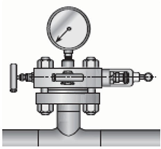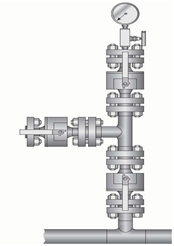Double block and bleed valves are used for primary and secondary isolation where bleeding the valve’s cavity is required. To properly understand double block and bleed valves, one must first understand the definitions established by API regarding double block and bleed (DBB) vs. double isolation and bleed valves (DIB).
Double block and bleed as defined by API 6D is a “single valve with two seating surfaces that, in the closed position, provides a seal against pressure from both ends of the valve with a means of venting/bleeding the cavity between the seating surfaces.” API 6D defines double isolation and bleed valves as a “single valve with two seating surfaces, each of which, in the closed position, provides a seal against pressure from a single source, with a means of venting/bleeding the cavity between the seating surfaces.”
There is an important distinction between DBB and DIB as they often fall under the same category and are used interchangeably within the industry. DIB valves can isolate either side of the valve regardless of the presence of upstream or downstream pressures. And often, DIB valves are referred to as “double block and bleed valves.” For further clarification and explanation, customers should consult the factory on product specifications and intended use.
WHAT AND WHY?
Once both block valves are sealed, the flow to downstream devices will stop. The residual media and pressure can be vented allowing for maintenance and repairs to begin without impacting the rest of the system. Using double block and bleed valves replaces the need for using three separate valves to perform the same function. This provides three major benefits: reducing the size and weight of the piping system, which lowers the amount of stress acting on pipes; reducing installation time and reducing the number of leak paths.
Figure 1 depicts a conventional, primary isolation double block and bleed pressure tap. It has a total of eight potential leak points, a cumbersome design and requires significant time to install as well as to maintain. Figure 2 displays a flanged valve with self-operated needle valves performing the same function as Figure 1. Two of the needle valves are used for isolation and one of the needle valves is used for venting to an integral pipe tap.
WHERE CAN I FIND DOUBLE BLOCK AND BLEED VALVES?
More specifically, DBB applications often consist of bypass loops for instrumentation, such as a flowmeter or pressure gauges, where calibration is required at prescribed intervals. Isolating upstream pressure, providing a backup seal, and venting captured pressure allows for removal or work to begin on an unpressurized downstream. A second seal is desirable due to the nature of the applications. Viscous and aggressive media can increase clogging and/or seal failure. Having a second isolation valve allows for increased safety during these routine maintenance operations. This is an important example of understanding the API definition as well as a manufacturer’s intended purpose for their products. The above application should be satisfied by using a DIB valve, whereas a DBB valve, such as a common trunnion ball valve with self-venting seals, has the potential of the first seal leaking and the vent valve becoming clogged. This could result in the upstream pressure overcoming the spring creating the second seal, ultimately compromising the second seal. A popular solution would be using an independently operated ball, needle or globe valves with a vent valve located in between.
In conclusion, it is imperative to fully understand the defi- nitions used to prescribe types of valves, especially when dealing with the isolation of pressure. The proper use of the large array of double block bleed valves (DBB & DIB) allows for safer, more cost-effective piping systems.
NICK CRALL is a project engineer for Richards Industrials currently tasked with New Product Development for the product line Steriflow Valve. He graduated from the University of Cincinnati with a Bachelor’s of Science degree in Mechanical Engineering Technology. Originally working on the product lines of Hex Valve and Bestobell Steam, Nick gained industry experience in industrial steam as well as oil and gas applications.
ANDREU TORRE PUJOL is a project engineer for Richards Industrials. He grew up in Spain where he graduated from the URV (Tarragona) with a Bachelors in Mechanical Engineering, and went on to receive his MBA and MEng in Mechanical Engineering from the University of Cincinnati. Andreu is the chief engineer responsible for Hex Valve, Bestobell Steam and the recently acquired line of sanitary diaphragm valves.
RELATED CONTENT
-
The Future of Valve Manufacturing is Already Here
Companies in the valve and control products industry are responding to a confluence of forces that are changing the landscape of manufacturing — automation, agility and digitalization to name a few.
-
Understanding Torque for Quarter-Turn Valves
Valve manufacturers publish torques for their products so that actuation and mounting hardware can be properly selected.
-
The Fundamentals of Gate Valves
The venerable gate valve remains a primary choice for many service applications.













 Unloading large gate valve.jpg;maxWidth=214)